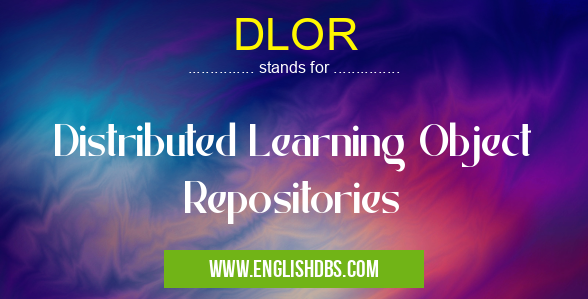What does DLOR mean in EDUCATIONAL
Within the educational community, DLORs play a crucial role in:

DLOR meaning in Educational in Community
DLOR mostly used in an acronym Educational in Category Community that means Distributed Learning Object Repositories
Shorthand: DLOR,
Full Form: Distributed Learning Object Repositories
For more information of "Distributed Learning Object Repositories", see the section below.
» Community » Educational
Meaning of DLOR in COMMUNITY
- Enhancing Collaboration: DLORs foster collaboration among educators by providing a platform to share and exchange teaching materials and resources.
- Promoting Resource Sharing: They facilitate the sharing of high-quality learning objects, increasing the availability of educational content for students and educators alike.
- Supporting Open Educational Resources (OER): DLORs serve as a hub for OER, making it easier for educators to find and incorporate freely available resources into their teaching practices.
Full Form of DLOR
The full form of DLOR is Distributed Learning Object Repositories. It refers to the distributed nature of these repositories, where learning objects are stored and managed in multiple locations, ensuring accessibility and redundancy.
Essential Questions and Answers on Distributed Learning Object Repositories in "COMMUNITY»EDUCATIONAL"
What is a Distributed Learning Object Repository (DLOR)?
A DLOR is a system that stores and manages digital learning objects (LOs) in a distributed network. It enables users to access, search, and retrieve LOs from various sources, promoting resource sharing and collaboration in online learning environments.
What are the benefits of using a DLOR?
DLORs offer several benefits, including:
- Resource sharing: Users can access a wide range of LOs from multiple providers, reducing the need for individual LO creation.
- Improved efficiency: DLORs streamline the process of finding and retrieving LOs, saving time and effort for educators and learners.
- Quality control: Centralized repositories can help ensure the quality and consistency of LOs, reducing the risk of using outdated or inaccurate materials.
- Collaboration: DLORs foster collaboration by allowing users to contribute, rate, and review LOs, promoting a shared knowledge base.
How does a DLOR work?
DLORs typically operate on a distributed network, where LOs are stored on multiple servers. Users can access the DLOR through a centralized interface, such as a search engine or web portal. The system searches for and retrieves LOs based on user criteria, and provides access to the LO or its metadata.
What types of LOs can be found in a DLOR?
DLORs can store a wide range of LOs, including:
- Multimedia resources (e.g., videos, images, audio files)
- Simulations and interactive content
- Assessment tools (e.g., quizzes, tests)
- Documents and presentations
- Learning modules and courses
Who can benefit from using a DLOR?
DLORs can be beneficial for a variety of users, including:
- Educators: Can access and incorporate high-quality LOs into their teaching materials.
- Learners: Can find and use relevant LOs to support their learning outside the classroom.
- Content creators: Can share and publish their LOs, contributing to the repository's resource pool.
- Researchers: Can use DLORs to study the use and effectiveness of LOs in online learning.
Final Words: DLORs are essential components of the educational landscape, providing educators with access to a vast pool of learning objects. They promote collaboration, resource sharing, and the integration of OER, ultimately enhancing the quality and accessibility of education. By leveraging DLORs, educators can create more engaging and effective learning experiences for their students.
